11.11.2021
NASA’s stalwart Mars helicopter is back and better than ever
Cumulatively, Ingenuity has now flown more than 3 km across the surface of Mars.
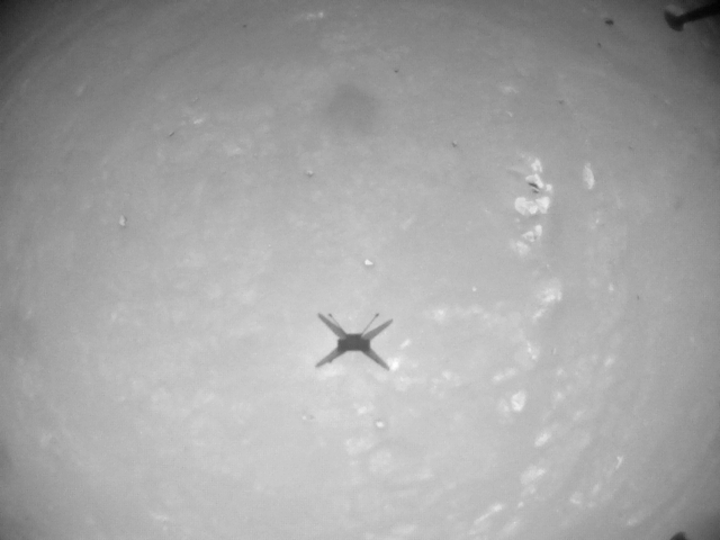
NASA's Ingenuity Mars Helicopter acquired this image using its navigation camera during its thin-atmosphere flight this week.
Nearly seven months have passed since NASA's Ingenuity helicopter made its first groundbreaking flight on Mars.
Since that initial tentative hovering above the surface of Mars, Ingenuity has flown a progression of longer, more significant, and scientifically important flights. It has flown as far as 625 meters in a single flight, as high as 12 meters, and for a duration of as long as 169.5 seconds.
But in September the small flying vehicle faced a growing threat from a thinning atmosphere due to seasonal variation. NASA's Perseverance mission had landed in Jezero Crater, in the northern hemisphere of Mars, during the planet's late winter in February. But since then summer has come on, and the density of Mars' atmosphere has fallen from about 1.5 percent that of Earth's atmosphere to 1.0 percent. For a helicopter already pushing the limits of flying in a thin atmosphere, this represented a significant decline.
NASA engineers devised a plan to compensate by increasing the rotation rate of Ingenuity's blades from a little more than 2,500 rpm to about 2,800 rpm. An initial flight test at a higher rotation rate, in September, raised concerns after Ingenuity failed to take off. Was this the end for a helicopter that had already survived far longer than its design life?
No, it was not. After engineers diagnosed a problem with the helicopter's small flight control motors and implemented a solution, Ingenuity was ready to try again. On October 24, Ingenuity executed a short flight at 2,700 rpm, rising about 5 meters and moving a horizontal distance of about 2 meters. This successful test gave engineers more confidence in trying a longer flight in Mars' thinner atmosphere at a higher rpm.
That happened this week, when Ingenuity completed its 15th overall flight on Mars, flying 128.8 seconds and about 400 meters across the surface of Mars. This flight proves that Ingenuity is capable of flying on Mars even in the thinnest atmosphere and sets the stage for future low-density-atmosphere scouting missions to check out scientifically interesting areas.
Here’s the best video yet of Ingenuity flying across Mars
The mission's planners don't know how long the plucky vehicle will last.
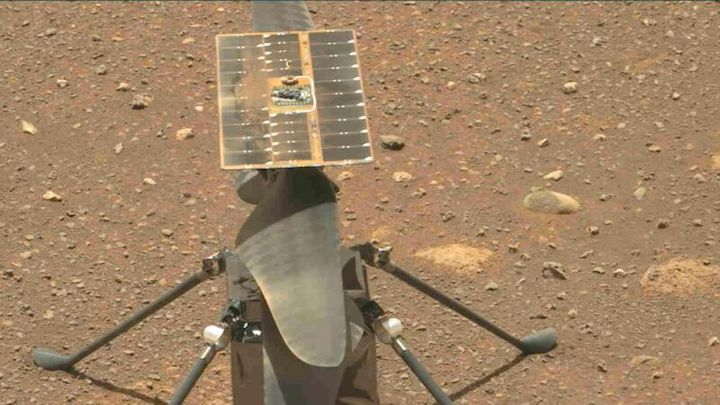
A close-up view of Ingenuity on Mars, as seen by the Perseverance rover, in April.
Back in early September the small Ingenuity helicopter that NASA sent to Mars along with the Perseverancerover made its 13th flight on the red planet.
It was a technically demanding flight, traversing nearly 210 meters across rocky terrain largely impassable to the rover. Ingenuity reached a maximum altitude of about 8 meters before landing safely again. But what makes this flight truly special is that Perseverance was able to track the helicopter's takeoff and flight.
Imagery from this flight was only recently relayed back to Earth, and the Mars rover team at NASA's Jet Propulsion Laboratory has compiled the data into a video showing nearly the entire flight. This footage offers by far the best view we've ever seen of Ingenuity flying across the surface of Mars.
At the time of the flight, Ingenuity was about 300 meters away from the rover. But fortunately Perseverancehas the most advanced pair of eyes ever sent to Mars. Located on top of the rover, the "Mastcam Z" instrument—the "Z" stands for zoom—has two cameras designed to provide the clearest possible imagery from Mars and make 3D imagery possible.
The un-zoomed footage shows this contrast nicely, with Ingenuity visible only as a tiny speck in the distance.
After this flight in September Ingenuity has taken things a little bit easier. It stood down for about six weeks during the Mars solar conjunction, when the red planet and Earth are on opposite sides of the Sun, making communications difficult. Ingenuity's engineers also had to deal with a problem affecting the helicopter's small flight control motors, and then a thinning atmosphere during the Mars winter.
To compensate for a thinner atmosphere, Ingenuity had to prove it could spin its blades faster than they were designed for. After a short test flight in late October, Ingenuity made a triumphant return on November 6 with a 407-meter flight across a wintry Martian surface, ascending to an altitude of 12 meters. Its next flight, the autonomous helicopter's 16th overall, could take place as soon as this Saturday.
The mission's planners don't know how long the plucky vehicle will last, because it has far out-lived its design lifetime, so they're just enjoying the ride. Thanks to this new video, we can as well.
Quelle: arsTechnica
----
Update: 25.11.2021
.
Mars helicopter Ingenuity soars on 16th Red Planet flight
The little Mars helicopter that could is pushing the limits of Martian flying.
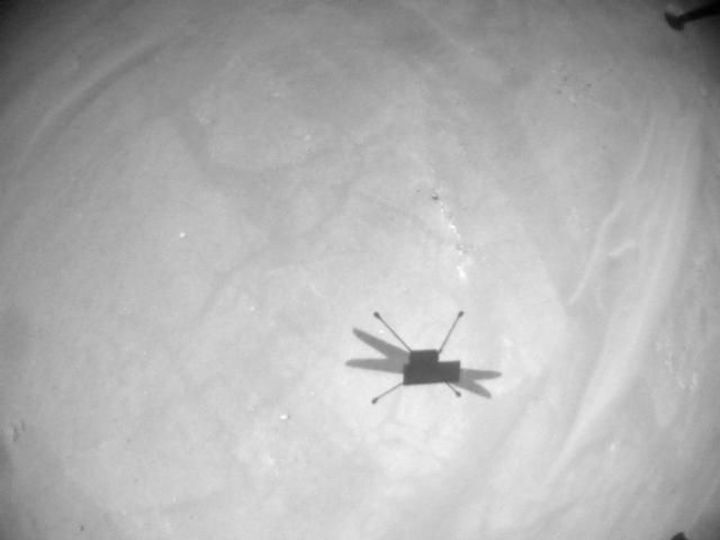
A photograph of the Ingenuity helicopter's shadow on the Martian surface captured during the chopper's 16th flight, on Nov. 21, 2021. (Image credit: NASA/JPL-Caltech)
NASA's Mars helicopter Ingenuity has aced yet another Red Planet flight, the little chopper's 16th sortie.
The Mars helicopter Ingenuity made its latest hop on Sunday (Nov. 21), about two weeks after its previous flight. According to a description of plans for the flight published on Nov. 16, the sortie was designed to carry Ingenuity one step closer to its original airstrip, dubbed Wright Brothers Field.
"#MarsHelicopter continues to thrive!" mission personnel wrote in a tweetposted Monday (Nov. 22). "The mighty rotorcraft completed its 16th flight on the Red Planet last weekend, traveling 116 meters northeast for 109 seconds. It captured color images during the short hop, but those will come down in a later downlink."
Ingenuity's first four flights on Mars, way back in April, all began and ended from Wright Brothers Field. And as originally designed, the mission was not meant to do much more: Ingenuity launched as a technology demonstration mission meant to fly only five times within a month.
But the chopper's early flights went so smoothly that NASA decided to extend its mission and send the little helicopter to scout out ahead of its larger companion, the Perseverance rover. Recent flights have seen Ingenuity cover regions dubbed Raised Ridges and South Séítah, which feature quite rough terrain for the rover to tackle but are particularly intriguing to geologists, hence the use of the airborne scout.
Ingenuity's current series of flights is hopping the little helicopter back to the Perseverance rover's landing site at Octavia E. Butler Landing in preparation for making a new excursion to a location dubbed "Three Forks" for the rover's second science campaign, according to a NASA plan published in June.
Although Ingenuity is showing no signs of flagging, the helicopter's journey has become more difficult during recent flights. The chopper, along with the rest of NASA's Mars fleet, was grounded for a few weeks earlier this autumn as the sun interrupted communications between Earth and the Red Planet.
Meanwhile, as the Martian seasons change, the atmosphere around Ingenuity is thinning, forcing the helicopter crew to increase the spin rateof the chopper's blades.
Quelle: SC
----
Update: 26.11.2021
.
NASA's Perseverance rover on Mars just snagged its newest rock sample (photos)
The new sample comes from the same rock Perseverance sampled earlier this month.
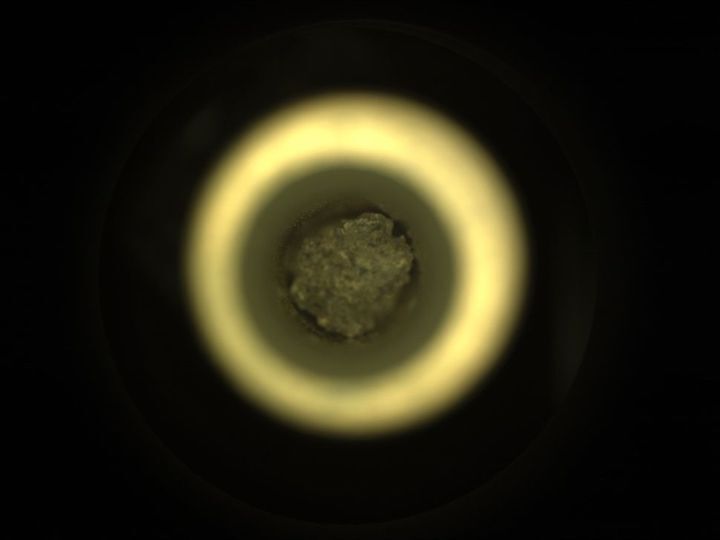
NASA's Perseverance rover captured this image of a successfully collected sample on Nov. 24, 2021, using its Sample Caching System Camera. (Image credit: NASA/JPL-Caltech)
NASA's Perseverance rover continues collecting Martian rocks.
The car-sized robot just snagged its fourth Red Planet rock sample, drilling another core from an intriguing stone that it first sampled a little over a week ago.
"A rock so nice, I sampled it twice! Just capped and sealed my fifth sample tube, with another piece from this interesting rock. I'm doubling up on samples at some high-priority targets like this one," Perseverance rover team members wrote Wednesday (Nov. 24) via the mission's official Twitter account, posting two photos of the sampling operation as well.
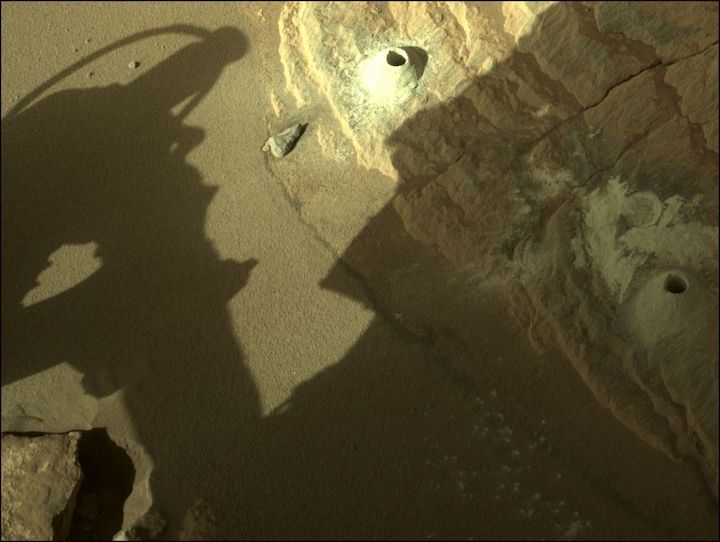
Perseverance collected two samples from the same Martian rock in November 2021. (Image credit: NASA/JPL-Caltech
Perseverance landed in February on the floor of Mars' Jezero Crater, which hosted a big lake and a river delta billions of years ago. The rover is hunting for signs of ancient Mars life and collecting dozens of samples, which a joint NASA-European Space Agency campaign will haul to Earth, perhaps as early as 2031.
Perseverance has sealed five sample tubes to date, as the above tweet notes. But one of those tubes is empty: The first rock the robot tried to sample, back in August, proved to be exceptionally soft, crumbling to bits that didn't make it into the designated titanium tube.
The newly collected sample comes from the same rock that Perseverance drilled on Nov. 15. That stone is rich in the greenish mineral olivine, a magnesium iron silicate that makes up most of Earth's upper mantle.
"There are several ideas among my science team about how it got there. Hypotheses are flying! Science rules," the Perseverance team tweeted on Nov. 16, when it announced the successful collection of sample number three.
Perseverance may be millions of miles from its home planet, but it's not alone. The rover landed with a tiny robotic partner, a 4-pound (1.8 kilograms) helicopter named Ingenuity, which has demonstrated that aerial exploration is possible on Mars.
Ingenuity is now performing scouting work for Perseverance. The little chopper has racked up 16 Red Planet flights to date, the most recent of which took place on Sunday (Nov. 21).
Quelle: SC
----
Update: 10.12.2021
.
NASA's eventual farewell to tiny Mars helicopter could be emotional
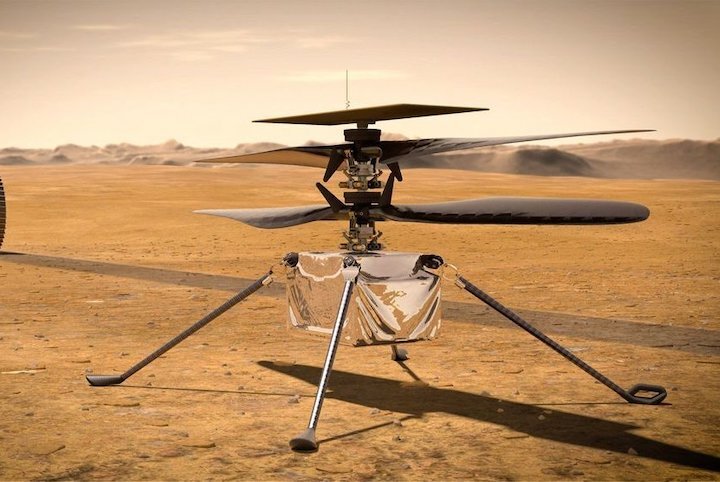
Dec. 9 (UPI) -- Tears most likely will flow at NASA's Jet Propulsion Laboratory in Pasadena, Calif., when the extremely successful Mars helicopter Ingenuity sends its last transmission and goes quiet on the Red Planet, according to those who have observed similar closures.
While the end of any space mission can be emotional simply because of a sudden change in routines and departure of colleagues, Ingenuity is unique, as it has opened a new type of robotic exploration and exceeded all expectations, said Christopher Hamilton, associate professor of planetary sciences at University of Arizona.
Ingenuity's team at NASA notched more success this past weekend with its 17th flight in the Red Planet's Jezero Crater, when it flew through some hills that briefly interrupted radio communication. But the tiny, 4-pound helicopter apparently came through unscathed, NASA said.
Ingenuity was designed to fly for 30 days to demonstrate that such a craft could navigate in the thin Martian atmosphere. But its mission has surpassed 7 1/2 months, witnessed a change of seasons on Mars, survived a near-total blackout of communications during a solar conjunction and performed vital scouting for the Perseverance rover.
Both the rover and the helicopter now are focused on finding interesting rocks for the rover to drill in a hunt for ancient signs of life.
"When the day comes that Ingenuity makes its final flight on Mars, there will be a mixture of emotions -- sadness that such an exceptional spacecraft has reached the end of its journey, but also triumph in that Ingenuity opened a new paradigm in Mars exploration," Hamilton said in an interview.
Hamilton has paid close attention to Ingenuity because he is leading an effort at the University of Arizona to study how rovers and aircraft, or multiple robotic explorers, could roam other planets in the future.
Funded with a $3.1 million grant from NASA, it's known as the Rover-Aerial Vehicle Exploration Network or RAVEN, and the plan is to send drones on exploration missions "across a vast lava field to test a next-generation Mars exploration concept," according to the university's Lunar & Planetary Laboratory.
"Ingenuity's achievements cannot be overstated, and it will be remembered as one of the great pioneering vessels of all time," Hamilton said. "One day, Ingenuity will make its last flight on the Red Planet, but it will not be the last aircraft to fly on Mars -- it's just the beginning."
Space missions bring together large groups of engineers, scientists and technicians who work under pressure for years. The end of such teamwork can also be emotional, said Ray Arvidson professor of Earth and Planetary Sciences at Washington University in St. Louis. He has been involved in every Mars mission since Viking landed there in 1976.
"Tears are not unusual at the end of such a mission, but I believe most of the emotion comes from a sense of accomplishment -- of satisfaction with a job well done," Arvidson said in an interview. "But you'll also miss the team. With the rovers, Spirit and Opportunity, we kind of grew up together, over two decades."
Arvidson added with a laugh, "We grew old and became gray together."
NASA has very little idea of how long the helicopter will last, Teddy Tzanetos, the Ingenuity team lead, said in an interview from the Jet Propulsion Laboratory. Eventually, engineers expect something will crack or break due to extreme temperature fluctuations on the Red Planet -- but they can't predict when.
In the meantime, NASA leadership has acknowledged that extending the mission adds to the original Ingenuity budget of $80 million but has stated that any increase would be minimal compared to what NASA is learning.
Previous missions lasted much longer than NASA planned -- notably the Opportunity rover, which had a budget and design for just 90 days of exploration in 2004. It didn't quit until 2019, almost 15 years later.
"Showing up to work each day to plan our next flight, you know, that's our new normal," Tzanetos said. "I'm sure, when that last flight occurs, whenever that happens, we will all miss it. But there will be a massive celebration of all the accomplishments."
Tzanetos also helps lead NASA's design research for a potential new Martian aircraft, known only as Mars Science Helicopter or Mars Heli. That aircraft could have twin rotors like Ingenuity or even six rotors.
Ingenuity's legacy has helped inform research on such future Mars aircraft, Hamilton said, adding that Mars drones in the future could have rotors and wings to extend their flights.
"Ingenuity changed planetary exploration just by flying the first time in April, but its additional accomplishments have pushed the technology even further," Hamilton said.
"It has demonstrated autonomous landings in new places -- a sort of marching forward and landing and exploring, which means the rate of future exploration will be radically different."
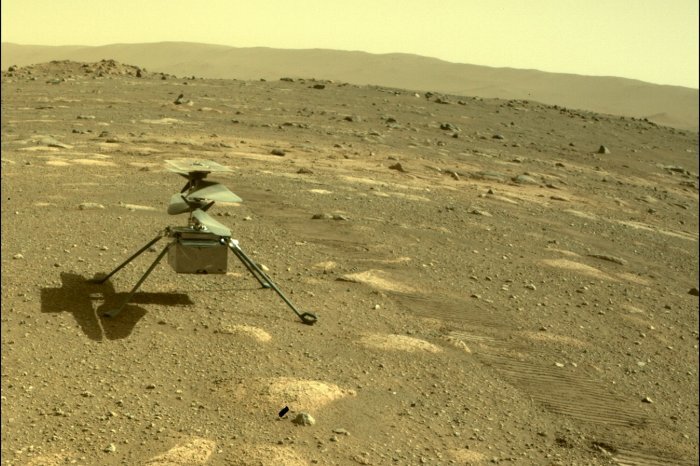
Perseverance acquired this image of the Ingenuity Mars Helicopter using its onboard Rear Left Hazard Avoidance Camera on April 4. The helicopter will soon make its first attempt at a powered, controlled flight of an aircraft on another planet. Photo courtesy of NASA |
Quelle: UPI
----
Update: 16.12.2021
-
Mars helicopter Ingenuity flies for 17th time on Red Planet
Everything appeared to go well, but team members are still waiting to get more data.

NASA's Ingenuity Mars helicopter acquired this image of its own shadow during its 17th Red Planet flight, on Dec. 5, 2021. (Image credit: NASA/JPL-Caltech)
NASA's Mars helicopter Ingenuity soared through the Red Planet skies for the 17th time last weekend, but we'll have to wait a little longer yet to get a full accounting of the flight.
The 4-pound (1.8 kilograms) chopper appeared to hit all of its marks during the 614-foot-long (187 meters) traverse, which occurred on Dec. 5. But the communication link between Ingenuity and its robotic partner, NASA's Mars rover Perseverance, was disrupted during the helicopter's descent, mission team members said. (All of Ingenuity's data and photos are relayed first to the Perseverance rover, and then to Earth through a Mars orbiter.)
"All available telemetry during and after the flight suggests that the activity was a success and that the loss of link was due to a challenging radio configuration between Perseverance and Ingenuity during landing," Teddy Tzanetos, Ingenuity team lead at NASA's Jet Propulsion Laboratory in Southern California, wrote in a blog post on Dec. 7.
"However, before planning our next flight, we need [to] transfer the missing data from Flight 17 from helicopter to rover, and then to Earth, so we can confirm vehicle health," Tzanetos added.
Two factors apparently led to the communication dropout, Tzanetos explained. One was terrain: As Ingenuity descended toward its landing spot, it became obstructed from Perseverance's perspective by a 13-foot-tall (4 m) hill the team calls "Bras."
The other issue was the rover's orientation. Ingenuity's radio communications had to cross much of the rover's body, including its power-producing radioisotope thermoelectric generator.
"When we originally planned Flight 17, we believed that the rover was going to be parked in a specific location and oriented in a certain direction," Tzanetos wrote. "However, Perseverance’s plans change day to day to maximize overall science return. By the time Flight 17 was ready for execution, Perseverance had driven to a new location and parked along a challenging heading for radio communications."
The Ingenuity team received some data from the helicopter on Dec. 5 and got their hands on another batch on Dec. 8. Everything indicates that Ingenuity is healthy and stable, Tzanetos wrote.
Ingenuity and Perseverance landed together on the floor of Mars' Jezero Crater in February 2021. The car-sized rover is hunting for signs of ancient Mars life and collecting samples for future return to Earth.
Ingenuity was originally tasked with showing that powered flight is possible on Mars. The chopper aced that technology-demonstrating mission long ago and shifted into a new role, which involves scouting Jezero terrain for Perseverance.
Quelle: SC
----
Update: 17.12.2021
.
Nasa's Perseverance Mars rover finds its 'baseline' rocks
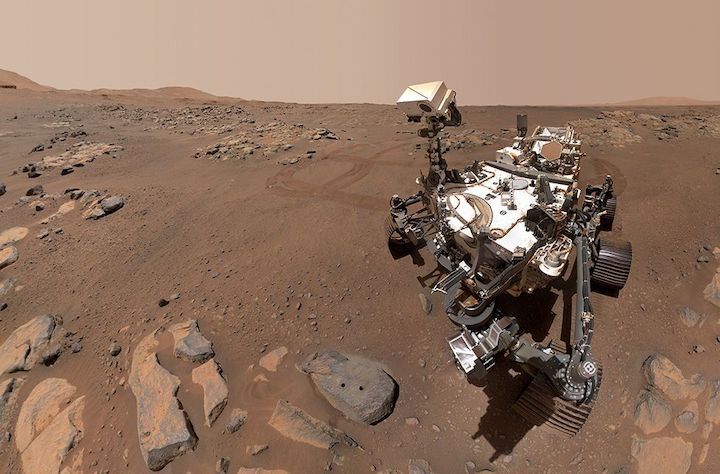
Nasa's Mars rover Perseverance has identified what are probably the oldest rocks at its crater landing site.
They are volcanic in origin, perhaps the product of some ancient lava flow.
It's an important milestone for the mission because it means that when samples of these rocks are returned to Earth next decade, they can be dated.
This will tighten our understanding of the history of not only the touch-down location but of Mars generally and the wider Solar System beyond.
Science team-member Briony Horgan, from Purdue University, said the identification represented a "really, really big deal".
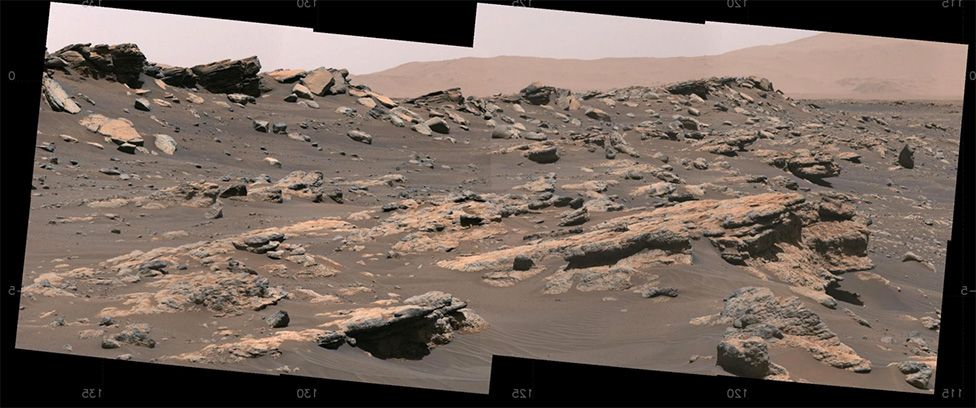 IMAGE SOURCE, NASA/JPL-CALTECH/MSSS
IMAGE SOURCE, NASA/JPL-CALTECH/MSSSPerseverance dropped into Jezero Crater in February.
This deep depression had been chosen as the destination because it appeared in satellite images to contain a delta - a structure built up from the silt and sand dumped by a river as it enters a wider body of water, such as a lake.
It's the kind of geological feature that just might record traces of past microbial life on Mars billions of years ago.
The rover didn't land on the delta itself but on the surrounding terrain - on the floor of the crater.
It's here that the robot has found its baseline rocks.
Perseverance was commanded to examine two broad areas: one dubbed the "Fractured Rough", the other nicknamed "Séítah" (meaning "amidst the sand" in the Navajo language).
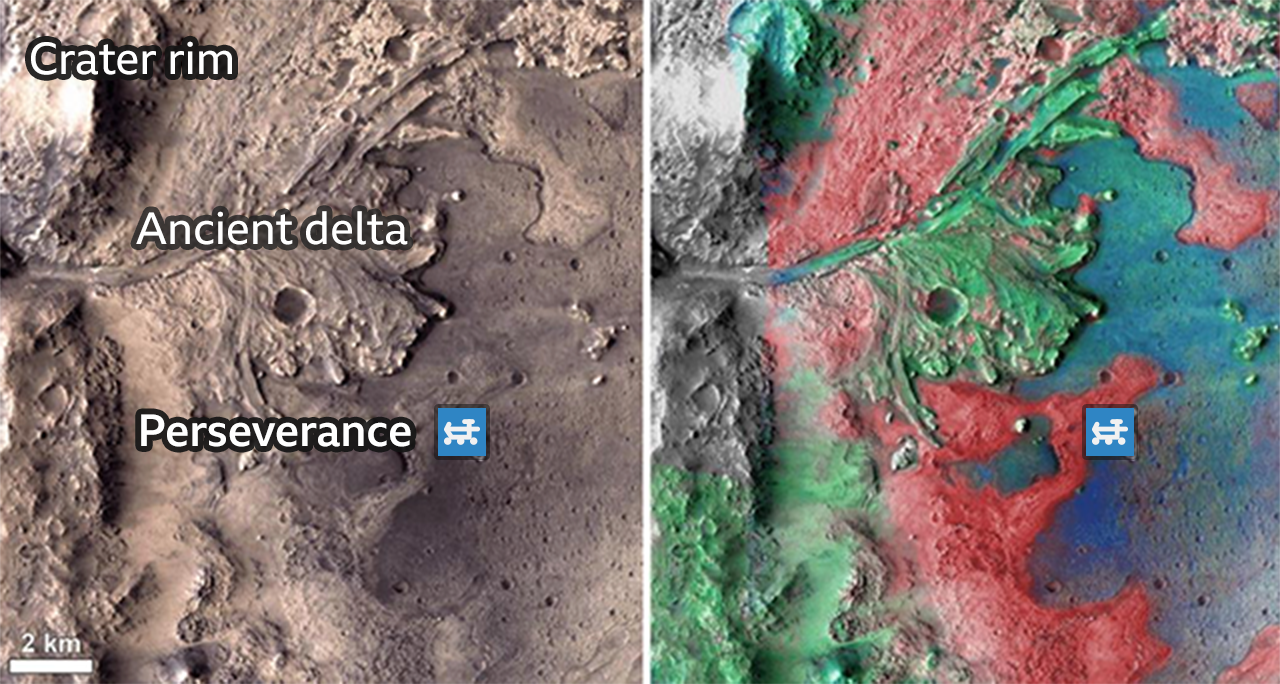 IMAGE SOURCE, NASA/JPL-CALTECH/MSSS
IMAGE SOURCE, NASA/JPL-CALTECH/MSSSThe scientists' immediate impression of the latter was that its rocks were sedimentary in origin - that is, they were the compressed accumulation of mineral particles deposited either in water or by the wind. This view was reinforced by the obvious layering.
But the mission team got something of a shock when Perseverance started drilling into Séítah and examining its geochemistry in detail.
Instruments detected lots of olivine crystals engulfed and surrounded by the mineral pyroxene.
Geologists describe what Perseverance saw as a cumulate texture, said Kelsey Moore from the California Institute of Technology (Caltech).
"And the reason that that's important is that a cumulate texture is very indicative of a specific type of igneous rock that forms as a very thick magma body is cooling, and the olivine crystals crystallise and sink and then the pyroxene forms around those olivine crystals," she explained.
Caltech colleague and Perseverance project scientist Ken Farley added: "So this appears to be a product that was either intruded into or erupted into the crater, or flowed in from outside. One potential explanation is that there was a phase in which there was a lava lake in the crater and it was filled with magma."
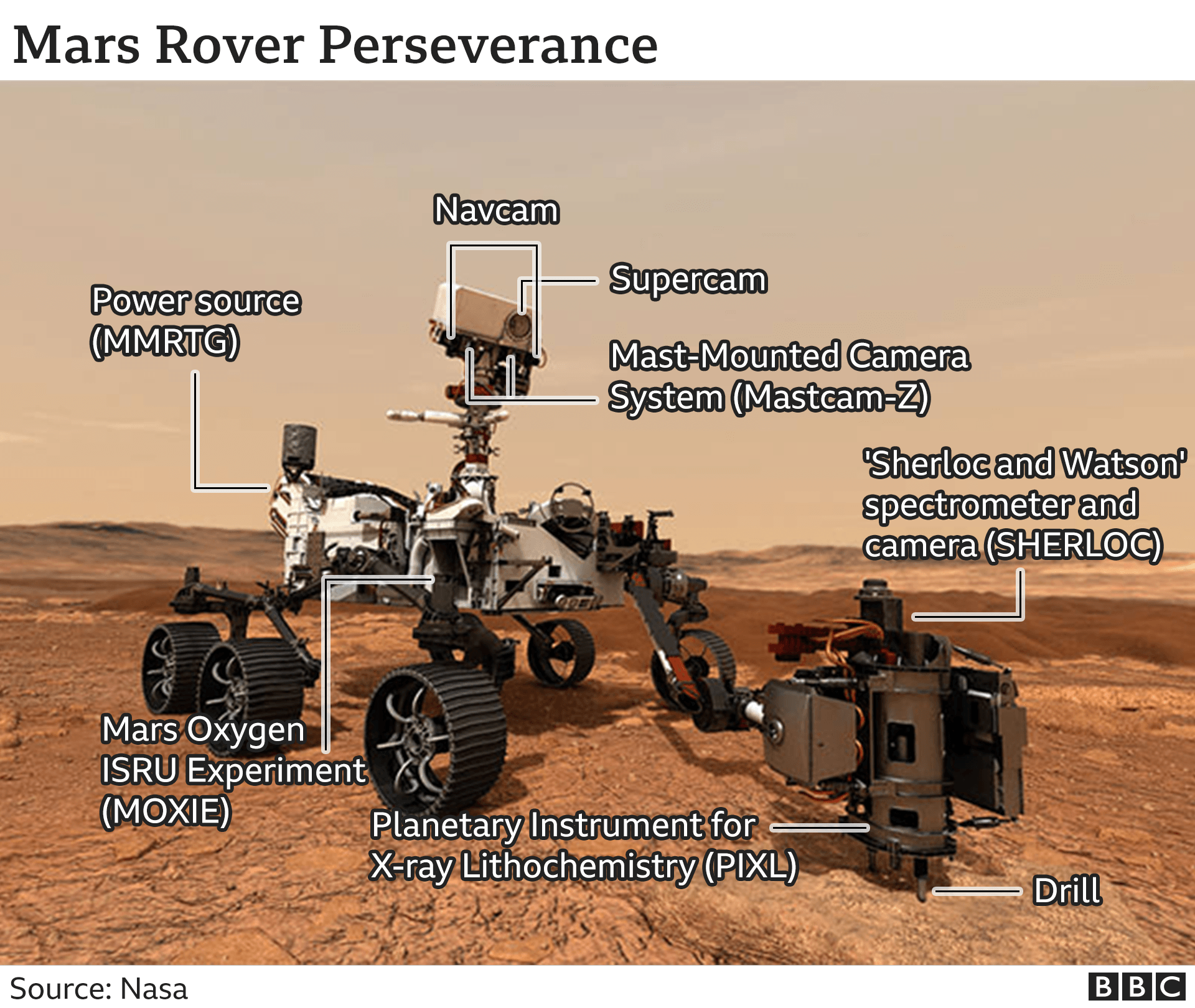
The team knows Séítah to be older than the Fractured Rough (also probably volcanic in origin) because Séítah can be seen in ground-penetrating radar images to dip under the Fractured Rough. A clear telltale of which rocks were emplaced first.
This almost certainly makes the Séítah outcrop the oldest rocks in Jezero - and much older than the delta.
Surfaces on all planetary bodies in the Solar System are aged by counting the number of their impact craters. Sophisticated models have been developed to compare ages across the various bodies. But these crater "chronometers" depend on some definitive dating that so far has only been obtained by ageing in the laboratory the rock samples brought back to Earth from the Moon in the 1960s and 1970s.
The pieces of rock drilled by Perseverance in Séítah and the Fractured Rough will also be returned to Earth at some point in the near future. Ages for them will be established by studying their radioactive content. The resulting definitive dates can then be used to extend and refine the crater-counting models.
And there'll be further interest in the Séítah samples when they arrive on Earth because Perseverance was also able to establish the presence of carbonate and sulphate minerals.
Kelsey Moore again: "[These minerals] indicate to us that after these igneous rocks formed, water flowed through the pore spaces and the cracks and voids in the rocks." The minerals would have precipitated from the water. "That tells us that there were aqueous environments in Jezero Crater after these rocks formed that may have been salty water. And that's important as we start to consider habitability in Jezero and the potential for life to have maybe existed in those kinds of waters."
Quelle: BBC
